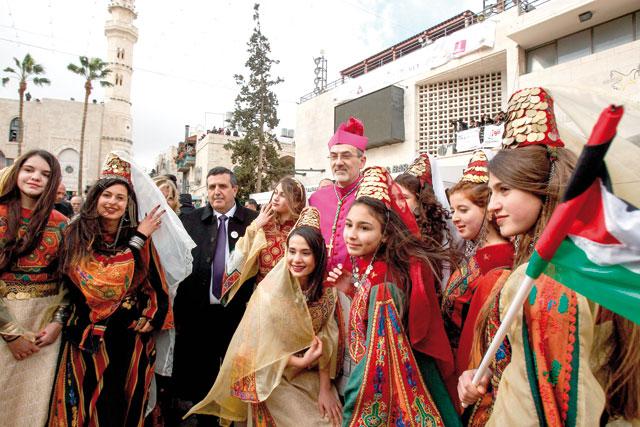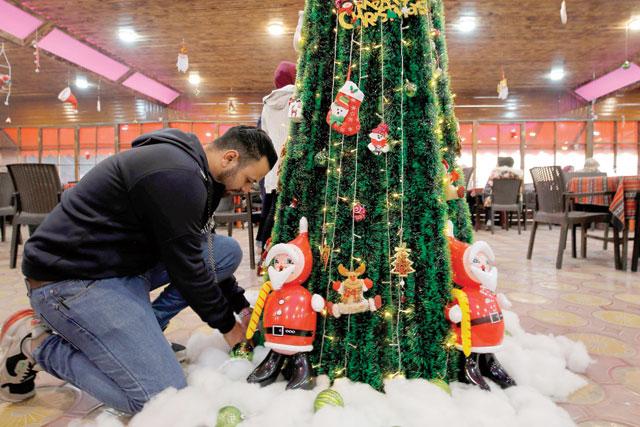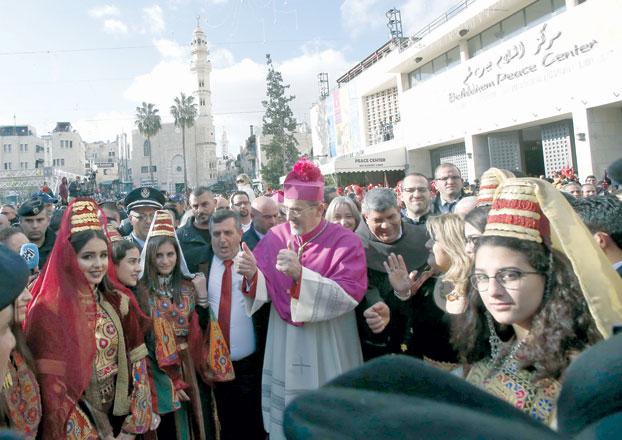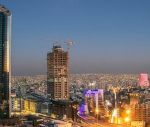You are here
Ravaged by war, Syria’s Homs relishes Christmas spirit
By AFP - Dec 21,2017 - Last updated at Dec 21,2017

A Syrian man decorates the Saint Mary Church of the Holy Belt (Umm Al Zennar Church) with a Christmas nativity scene in the Christian-majority neighbourhood of Hamidiyeh in the old city of Homs on December 17 (AFP photo)
HOMS, Syria — The metallic green Christmas tree towers over the bombed-out heart of Syria's third city Homs, where residents are relishing a holiday cheer they have not felt in years.
They have been busy putting the final decorative touches on the tree in Hamidiyeh, a neighbourhood in the ravaged Old City of Homs, where ferocious street battles pitted regime forces against rebels between 2011 and 2014.
One volunteer hammered a metal platform in place ahead of a choir concert and children's shows, and the futuristic artificial Christmas tree is to be lit up on Thursday.
"In 2014, when we had just returned to this destroyed neighbourhood, our Christmas tree was made of rubble," said Roula Barjour, the executive director of charity NGO Bayti, or "My House", in Arabic.
"But this year, with the return of residents and of life, people are finding cheer again," the 46-year-old told AFP, between delegating tasks to young volunteers.
One stood out: Abdo Al Yussefi was well into his sixties, but the local resident insisted on joining the holiday preparations.
He pulled crates of Christmas decorations up to the tree, already spruced up with curling blue and silver garlands.
"The Christmas tree used to be a joy just for children, but now it's for everyone, young and old," said Yussefi, wiping his brow with a white napkin.
"The tree gathers us all around it."
The scars of the battles that gripped Homs are still visible: partially-destroyed buildings, collapsed or pockmarked walls, and piles of sandbags can be found across the Old City.
When Syria's conflict began in 2011, mass demonstrations rocked Homs, which activists dubbed the "capital of the revolution".
But after years of government siege and bombardment, rebels agreed in 2014 to a deal that brought most of the city under regime control.
A second pact earlier this year put the rest of Homs fully in government hands.
Grinning, Yussefi gestured to the volunteers around him: "As you can see, all the neighbourhood's residents are working together, smiling like little kids."
He asked one to snap a photograph of him near the Christmas tree to send to his children, now living in Germany.
"I want to ask them to come back, because happiness has come back to Homs," Yussefi exclaimed.
Many of its 800,000 residents fled when war erupted, but tens of thousands have trickled back, including to the Old City.
Across the street, construction workers have been repairing damaged homes.
A nearby wall was dotted with posters bearing photos of men, young and old, killed in the Homs fighting.
Some of the posters on the "Wall of Honour", as it is labelled, have been torn and faded by several winters.
But the picture of Dutch priest Father Frans van der Lugt, killed inside Homs's Jesuit monastery by unknown assailants in April 2014, remains vivid.
He was buried at the monastery, which has become a pilgrimage site for Syrians.
Homs's Old City had a significant Christian population before the war and is home to several ancient churches, including the celebrated St Mary Church of the Holy Belt, named after a venerated relic said to be a section of the belt of Mary, mother of Jesus.
Inside the silver-stoned structure, young people erect a nativity scene depicting the birth of Jesus.
"There was always a sadness in past holidays, because of the people that were killed and the destruction of the churches. We'd pray over rubble," said church caretaker Imad Khoury.
"But today, the church has been restored and the decorations are back. Our celebration this year feels like those from before the war."
Clashes heavily damaged part of the Chuch of the Holy Belt and left another section burned, and the road leading to it remains punctured by a huge crater.
But inside, restoration is almost complete, with new wooden benches, a large icon of the Virgin Mary perched in a corner, and decorative red stars dangling from the ceiling.
"We brought back valuable icons that we hid because they were damaged during the war, and also acquired new ones," said another church caretaker, 66-year-old Mikhail Owel.
The serene tones of a choir practising hymns bounce off the church walls, in preparation for a concert on Christmas Day.
Music was also playing several streets away at the famous Julia Palace Restaurant, which also underwent repairs last year and is now ready for business.
Owner Malek Trabulsi was excitedly counting the restaurant reservations as workers hanged Christmas lights around the grandiose establishment.
"After too many funerals, we're having weddings again. After fleeing during the war years, customers are filling the restaurant," said Trabulsi.
"The painful occasions are over. Today, Homs is safe and ready to announce the end of its mourning."
Related Articles
BETHLEHEM, Palestinian Territories — Palestinian scouts played drums and bagpipes as Christmas celebrations began in Bethlehem on Sunday, bu
GAZA CITY — With a shining tree, tinsel and Santa miniatures, Hanadi Missak's apartment is all ready for Christmas, yet she still feels sad
BETHLEHEM, Palestinian Territories — Pilgrims from across the world gathered in Bethlehem on Monday for Christmas Eve, queueing to see the g

















